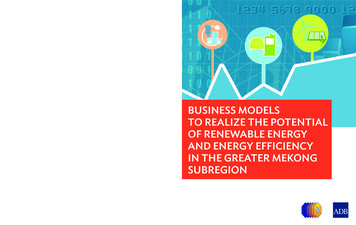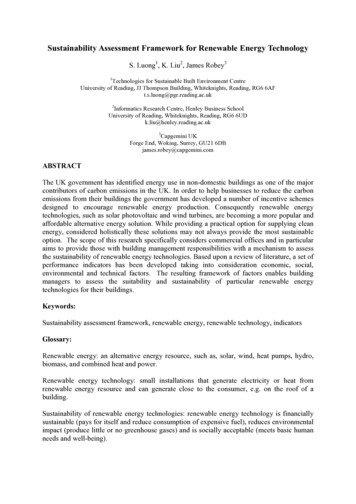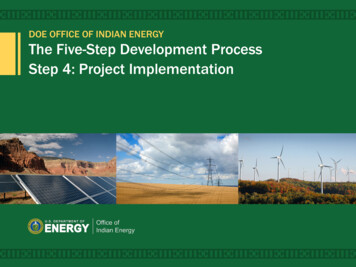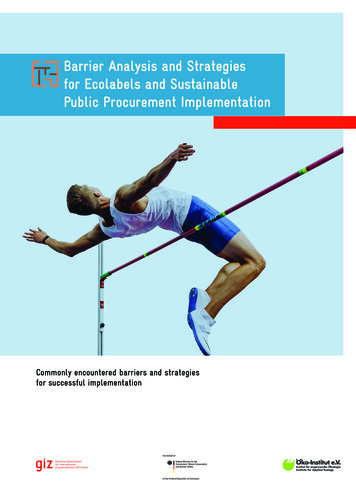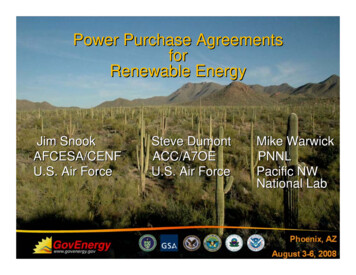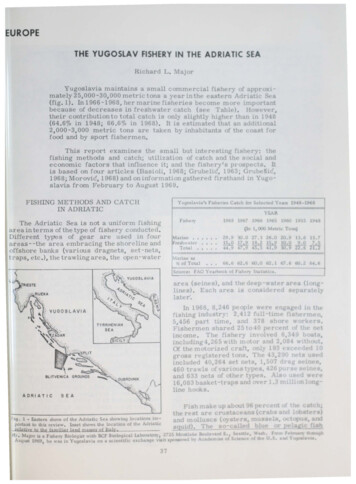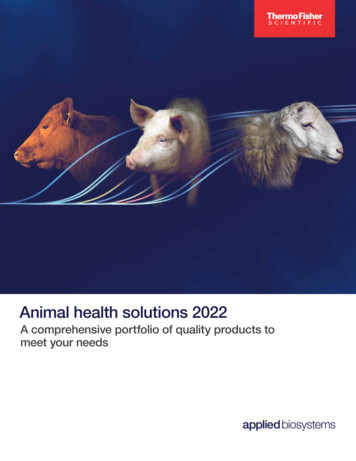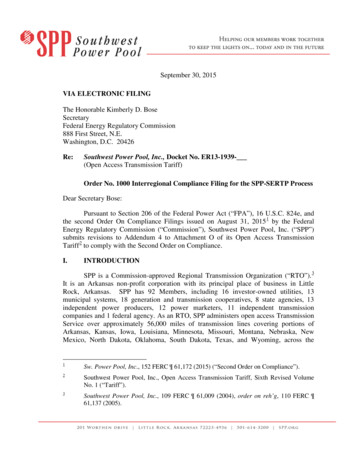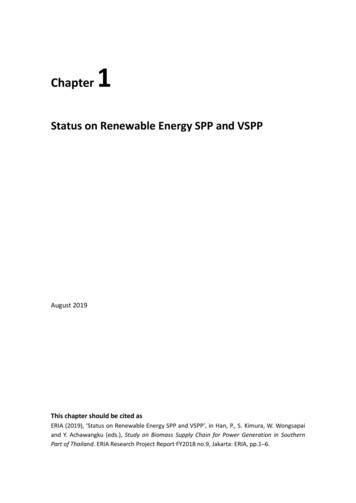
Transcription
Chapter1Status on Renewable Energy SPP and VSPPAugust 2019This chapter should be cited asERIA (2019), ‘Status on Renewable Energy SPP and VSPP’, in Han, P., S. Kimura, W. Wongsapaiand Y. Achawangku (eds.), Study on Biomass Supply Chain for Power Generation in SouthernPart of Thailand. ERIA Research Project Report FY2018 no.9, Jakarta: ERIA, pp.1 6.
Chapter 1Status on Renewable Energy SPP and VSPP in SouthernThailandThis chapter reviews the status of small power producers (SPPs) and very small power producers(VSPPs) of renewable energy (RE) in Thailand, including the recent policy and privileges forpurchasing RE.1. History of Thailand’s SPP SchemeThe SPP scheme was established on 17 March 1992 through an endorsement by Thailand’s cabinet.The scheme aims to promote power generation by using alternative fuel and waste, includingcogeneration, to efficiently use domestic alternative resources and by-product energy. This conceptalso decreases the government’s duty to invest in power infrastructure.The National Energy Committee, on 26 December 2006, endorsed the Electricity GeneratingAuthority of Thailand (EGAT) to purchase 3,200 MW to 4,000 MW of electricity generated from allkinds of fuel. After that, EGAT, the Provincial Electricity Authority and the Metropolitan ElectricityAuthority issued the small power purchasing announcement in 2007. Purchasing would coverexisting capacity of 10 MW–90 MW, which is classified by (i) SPP cogeneration firm contract, (ii) SPPfirm contract (RE), and (iii) SPP non-firm contract.In 2017, the Ministry of Energy launched a new SPP scheme called the ‘SPP Hybrid-firm.’ This allowedpower producers to use two kinds of alternative fuel or more to generate power and sell to EGAT inorder to increase production of stable power from RE. Several criteria were set under this scheme:1) It is available to new RE power plants with an existing capacity of 10 MW–50 MW.2) Power plants must operate 100% during peak time, and 65% in off-peak time.3) Fossil fuel utilisation is prohibited (except during system start-up).4) Purchasing rate is feed-in tariff (FiT) bidding at 3.66 baht (B)/kWh.2. History of the VSPP Scheme of ThailandThe VSPP scheme started on 14 May 2006 when the Thai cabinet agreed to regulate the VSPPs.Power producers can enter into power purchasing contracts with the Metropolitan ElectricityAuthority or the Provincial Electricity Authority (depending on the power plant’s location). Thisscheme aims to promote the use of domestic resources, increase the stability of nationaltransmission by distributing power generation, reduce the government budget for the construction1
of new power plants, as well as contribute to the operation of conventional power plants duringpeak time.At the beginning, the VSPP contract was available to power plants with an existing capacity of lessthan 1 MW. In 2007, the Energy Policy Administrative Committee endorsed to extend the maximumcapacity of the VSPPs from 1 MW to 10 MW. Then, adder, or feed-in premium, was established bytopping-up a special rate to the normal purchasing price (Table 1.1).Table 1.1: Adder Rates for the VSPPRE SourcesAdder Rate (B/kWh)Subsidy Period (year)Solar8.00Wind2.50Municipal solid waste2.50Small hydro (50–200 kW)0.40Small hydro (less than 50 kW)0.80Biomass0.30Biogas0.30B baht, kWh kilowatt-hour, RE renewable energy, VSPP very small power producer.Note: Adder for solar decreased from B8.00/kWh to B6.50/kWh in 2010.Source: Provincial Electricity Authority (PEA), Thailand Adder Rates as of 2013.101077777In June 2007, the National Energy Committee endorsed the premium adder rate to promote powerplants in border southern provinces (Yala, Pattani, and Narathiwat) and four districts in SongkhlaProvince (Nathawee, Saba Yoi, Jana, and Thepha). Biomass, biogas, municipal waste, and small andmicro hydropower earned more 1 baht (B)/kWh topping up from ordinary adder, whereas solar andwind obtained more B1.50/kWh rate to normal adder.With the SPP hybrid-firm announcement, the VSPP semi-firm scheme was replaced to subsidisepower producers that can generate more electricity during peak periods. This scheme was availableto new RE power plants that use biomass, biogas from wastewater or energy crop, and municipalsolid waste (also called trash or garbage, defined nationally as wastes consisting of everyday items,which generate 10 MW or lower). Power plants must be operating for 6 months under a firm contract(100% power operation in peak time, and lower than 65% during off-peak), which must cover themaximum power consumption period (March to June) and 6 months for non-firm condition. Like theSPP hybrid firm, fossil fuel can be used only during the start-up period, and an energy storage systemcan be applied.3. Feed-in TariffReplacing adder, the FiT scheme for rooftop and ground-mounted solar photovoltaic power projectswas introduced with a total capacity of 200 MW and 800 MW, respectively, and contract duration of25 years. The target was to fulfil the allocated capacity cap by 2014. Then, for non-solar renewables,the Ministry of Energy launched the FiT scheme for the VSPPs with less than 10 MW installed capacitycovering power from waste gasification, landfill gas, biomass, biogas, hydro, and wind in 2014.2
RE sources of power generation in Thailand are varied, such as hydropower, biomass, biogas, solarcell. These technologies must face the uncertain resource availability pattern and fluctuating fuelprices. Therefore, the FiTs for this group are formulated with three components, as follows:1) a fixed-based tariff (FiTF), which is calculated from capital, and operations and maintenance(O&M) costs of each renewable technology;2) a variable-based tariff (FiTV) for bioenergy (except landfill projects) calculated from the fuelcost and dependent on the inflation rate; and3) an additional premium (FiTP) for projects that use bioenergy (except landfill projects) for thefirst 8 years.Figure 1.1: Structure of FiT for RE Technologies Using BioenergyFiT feed-in tariff, RE renewable energy.Source: Energy Policy and Planning Office (EPPO), Ministry of Energy, as of 2015.3
Table 1.2: FiT Rate for Electricity Generated from Bioenergy SourcesFiT (B/kWh)Capacity (MW)FiTFFiTvFiT Premium (First 8 years)Adder forSouthernProvinces**Bioenergy projects1. Waste-to-energy (integrated waste management)Installed capacity 1 MW3.133.216.34200.70.5Installed capacity 1–3 MW2.613.215.82200.70.5Installed capacity 3 MW2.392.695.08200.70.55.60-5.6010-0.5Installed capacity 1 MW3.132.215.34200.50.5Installed capacity 1–3 MW2.612.214.82200.40.52. Waste (landfill)3. BiomassInstalled capacity 3 MW2.39 1.85 4.24200.30.54. Biogas (wastewater,manure)3.76- 3.76200.50.55. Biogas (energy crop)2.79 2.55 5.34200.50.56. Hydro energyInstalled capacity 200MW4.90- 4.90200.507. Wind energy6.06- 6.06200.50Notes: B/kWh Thailand baht per kWh of electricityFiT feed-in tariff.FiTF fixed-based tariff, calculated from initial investment of the power plant construction and the fulllifetime of its operation and maintenance cost.FiTV variable-based tariff, feed-in tariff variable, calculated from investment cost of raw materials used forpower generation that changes according to time.* FiT FiTF FiTV. This FiT rate will only apply to projects that feed electricity into the system withinthe year 2017. After 2017, FiTV rate will continuously increase according to the core inflation rate. This onlyapplies to waste (integrated waste disposal), biomass, and biogas (energy crops) categories.** Projects in Yala, Pattani, Narathiwat and Chana, Thepha, Saba-Yoi, and Na-Thawi districts inSongkhla provinces.Source: Energy Policy and Planning Office (EPPO), Ministry of Energy, as of 2015.4
4. Status of the SPPs and the VSPPs in Southern ThailandThe Energy Regulatory Committee summarised the overall status of RE SPPs and VSPPs. In November2018, 13 SPPs were using renewable sources with 347.90 MW in existing capacity, while the totalpurchasing capacity was 313.47 MW.For the VSPPs, 122 plants were using RE, with total existing capacity of 534.20 MW and totalpurchasing electricity of 476.61 MW. Table 1.3 summarises the SPP and VSPP status.Table 1.3: Status of Renewable SPPs and VSPPs in Southern ThailandSPPTypeVSPPAmountof PlantExisting(MW)Purchasing(MW)Amountof y PPA (not CODyet)24641.6225134.33129.80Already 476.61Accepted for purchasing(not yet PPA)TotalCOD commercial operation date, PPA power purchasing agreement, SPP small power producer,VSPP very small power producer.Source: Energy Regulatory Commission (ERC), as of November 2018.5. Biomass Power Plant in Southern ThailandSouthern Thailand is rich with biomass, such as rubberwood; entrepreneurs are thus attracted andinterested to invest in biomass power plant projects in the area. Likewise, due to special privilegesgranted by the government in the southern provinces, both SPPs and VSPPs are mechanisms toencourage constructed and supplied electricity to the national transmission line.5
Figure 1.2: Existing Capacity of COD Biomass Power PlantSource: Energy Regulatory Commission (ERC).http://www.erc.or.th/ERCSPP/default.aspx?x 0&muid 23&prid 41In November 2018, biomass power plants had already sold 237.11 MW of electricity to the grid(COD). Suratthani and Nashon Sri Thammarat became the two power plants with the highest existingcapacity (48.3 MW and 46.7 MW, respectively). These provinces have a large rubberwood plantationarea. Also, Phuket, Pang Nga, Pattani, and Ranong do not have biomass power plants.6
The VSPP scheme started on 14 May 2006 when the Thai cabinet agreed to regulate the VSPPs. Power producers can enter into power purchasing contracts with the Metropolitan Electricity Authority or the Provincial Electricity Authority (depending on the power plant's location). This scheme aims to promote the use of domestic resources, increase .


